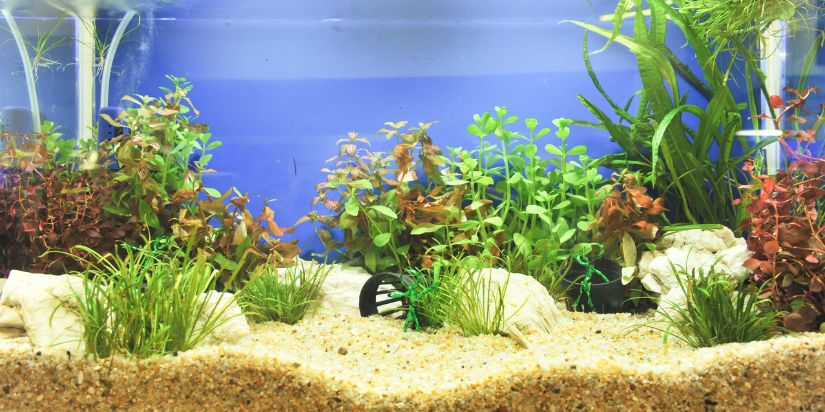So, you’ve decided to install an aquarium. Have you considered what it should be made of? There are two primary materials the walls of your tank can be made of: glass and acrylic. What are the differences? How do you decide the best option between an acrylic vs. glass aquarium?
The three main things that differentiate an acrylic tank vs. glass are damage resistance, weight and natural insulation. There are some minor distinguishing factors as well. Let’s take a closer look at each of these differences. That way, you can make an informed decision on which kind of tank is best for you.
Before diving in, check out the custom aquariums made by Living Art Aquatics in Crystal Lake, IL. Every aquarium is customized to fulfill your fish tank dreams.
Scratch-Resistance vs. Shatter-Resistance
The first difference between acrylic and glass aquariums is how they resist damage: glass aquariums are scratch-resistant, while acrylic aquariums are shatter-resistant. Are acrylic tanks better than glass in this category? Not necessarily. Which one you prefer depends on your situation.
Acrylic is strong but soft, so it won’t break but accumulates scratches. Fish can even scratch acrylic from the inside. If a professional technician handles most of your maintenance, they likely won’t be so concerned about significant impacts. Instead, they’re more worried about making minor accidental scratches with their tools.
That’s why commercial aquariums in hospitals and other workplaces prefer glass tanks. They minimize the unsightliness and murkiness caused by scratches.
However, if you’re installing a residential aquarium, you might prefer acrylic. You may have children running about and throwing things around. Maybe you have other reasons to worry about something hitting the aquarium. Glass protects against scratches but is brittle and shatters when there’s a significant impact. That’s why you might prefer an acrylic aquarium in this situation.
Keep this additional detail in mind, though: scratches on acrylic can be buffed out, but scratches on glass can’t. If you do manage to scratch the glass, you’ll be stuck with it unless you replace it. If you scratch acrylic, you can take some extra time and polish off the scratches with wet sandpaper. That’ll make it look good as new. However, the scratches caused by fish on the inside of the tank will take a bit more time to get to.

Glass Weighs More
The next major difference between an acrylic vs. glass aquarium is weight. Glass weighs significantly more, and this matters more and more for larger tank sizes.
How much more? Depending on size, an empty glass aquarium weighs almost twice as much as an empty, well-built acrylic aquarium.
At smaller sizes, this isn’t too big of a deal. A 55-gallon tank weighs about 42 pounds when made of acrylic and about 78 pounds when made of glass but requires two people to lift either way. However, larger sizes can create more of a problem. A 500-gallon acrylic tank weighs about 600 pounds and needs five people to lift, while a 500-gallon glass tank weighs about 1,050 pounds and requires eight people.
Weight is an important factor if you’re getting a larger tank and are worried about a potentially difficult installation process or if you foresee picking up or moving the tank at any point. That’s why an acrylic tank that weighs less is a better choice for large aquariums.
To get an idea of approximately how much your aquarium might weigh, use this tank weight calculator.
Acrylic vs. Glass Aquarium: Heat Retention or Dispersment?
The third major difference between an acrylic vs. glass aquarium is how they hold (or disperse) heat. Glass lets more heat out, while acrylic holds more heat in. Just like with the first point, which of these is preferable depends on your situation.
This difference is due to how these two materials are structured on a molecular level. Glass is more chaotic, so heat more easily escapes through it. Acrylic is more crystalline and uniform, insulating better and keeping more heat in the aquarium.
If your aquarium has problems with overheating, especially in the summer, you may want to consider switching to a glass tank. On the other hand, if your aquarium has problems holding heat, you may want to switch to acrylic.
This is a critical consideration when you have an aquarium where temperature is more important and has to stay within a narrower range. Examples include a community aquarium with a coral reef. You may also opt for one over the other if you live in a climate with very high or low temperatures.

Other Differences Between an Acrylic vs. Glass Aquarium
Those are the three most significant differences between an acrylic vs. glass aquarium. There are some smaller differences between the two as well, though. Here are some of the highlights:
- Visual distortion—When looking at a glass aquarium, you may have noticed that the view of the inside is somewhat distorted. As we discussed above, acrylic has a more uniform, crystalline structure. This makes it optically clearer than glass, with less visual distortion. This difference isn’t all that noticeable on smaller tanks with thin panes of glass or acrylic, as glass tech has been catching up in recent years. Still, the bigger the tank and the thicker the pane, the more of a difference. If you don’t want thick glass distorting your view, that’s one more pro for acrylic.
- Cost—A glass aquarium tends to be cheaper than an acrylic aquarium. At smaller sizes, even higher-quality glass has comparable pricing to acrylic.
- Bonding and seams—Glass aquariums are typically joined at the seams using several methods. An injection-molded frame might hold it all together, improving durability but impairing your view. Alternatively, silicone may be used, which isn’t as durable but keeps the view from being impeded. On the other hand, acrylic is chemically bonded together.
- Filter and pump installation—Installing a sump and tubing may require drilling. Since acrylic is plastic, this doesn’t pose any issues, and you can do it yourself. With glass, you first have to ensure it’s not tempered and then drill at your own risk. If you’re performing this task yourself, it’s certainly easier with acrylic.
Acrylic vs. Glass Aquarium: Which Will You Choose?
You now have all the information you need to make an informed decision between an acrylic vs. glass aquarium. Which will you choose?
Do you still have questions? Want professional advice catered to your specific situation? Or, are you ready to have your custom aquarium built to bring your vision to life? Call Living Art Aquatics! We’ve been designing, installing and maintaining aquariums for over 20 years in the Chicagoland region. Together, let’s make living art!
Editor’s Note: This blog was originally published in June of 2017 and was updated in May of 2024.







